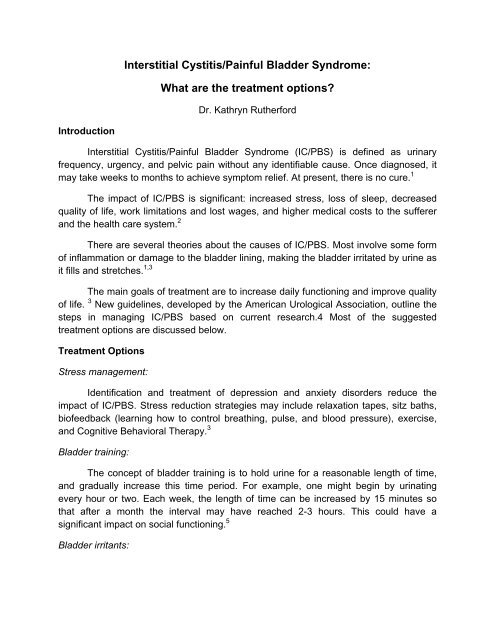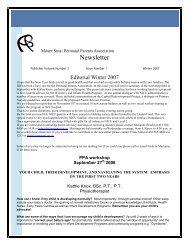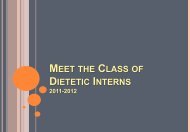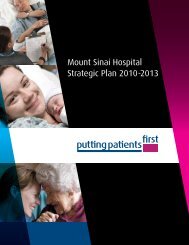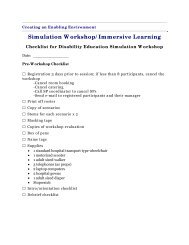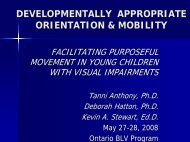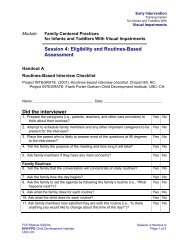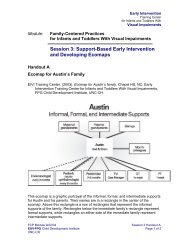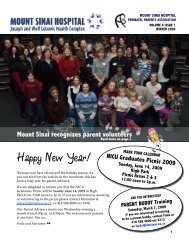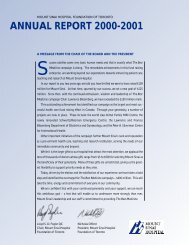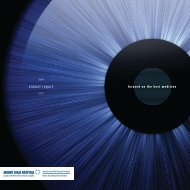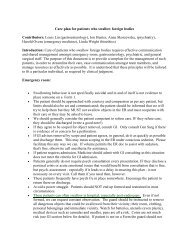Interstitial Cystitis/Painful Bladder Syndrome - Mount Sinai Hospital
Interstitial Cystitis/Painful Bladder Syndrome - Mount Sinai Hospital
Interstitial Cystitis/Painful Bladder Syndrome - Mount Sinai Hospital
You also want an ePaper? Increase the reach of your titles
YUMPU automatically turns print PDFs into web optimized ePapers that Google loves.
<strong>Interstitial</strong> <strong>Cystitis</strong>/<strong>Painful</strong> <strong>Bladder</strong> <strong>Syndrome</strong>:<br />
What are the treatment options?<br />
Dr. Kathryn Rutherford<br />
Introduction<br />
<strong>Interstitial</strong> <strong>Cystitis</strong>/<strong>Painful</strong> <strong>Bladder</strong> <strong>Syndrome</strong> (IC/PBS) is defined as urinary<br />
frequency, urgency, and pelvic pain without any identifiable cause. Once diagnosed, it<br />
may take weeks to months to achieve symptom relief. At present, there is no cure. 1<br />
The impact of IC/PBS is significant: increased stress, loss of sleep, decreased<br />
quality of life, work limitations and lost wages, and higher medical costs to the sufferer<br />
and the health care system. 2<br />
There are several theories about the causes of IC/PBS. Most involve some form<br />
of inflammation or damage to the bladder lining, making the bladder irritated by urine as<br />
it fills and stretches. 1,3<br />
The main goals of treatment are to increase daily functioning and improve quality<br />
of life. 3 New guidelines, developed by the American Urological Association, outline the<br />
steps in managing IC/PBS based on current research.4 Most of the suggested<br />
treatment options are discussed below.<br />
Treatment Options<br />
Stress management:<br />
Identification and treatment of depression and anxiety disorders reduce the<br />
impact of IC/PBS. Stress reduction strategies may include relaxation tapes, sitz baths,<br />
biofeedback (learning how to control breathing, pulse, and blood pressure), exercise,<br />
and Cognitive Behavioral Therapy. 3<br />
<strong>Bladder</strong> training:<br />
The concept of bladder training is to hold urine for a reasonable length of time,<br />
and gradually increase this time period. For example, one might begin by urinating<br />
every hour or two. Each week, the length of time can be increased by 15 minutes so<br />
that after a month the interval may have reached 2-3 hours. This could have a<br />
significant impact on social functioning. 5<br />
<strong>Bladder</strong> irritants:
Certain foods and beverages, (plus smoking!) have been found to increase<br />
bladder irritation. These include: alcohol, caffeine, acidic foods (citrus, tomatoes), spicy<br />
foods, artificial sweeteners (diet pop), foods rich in potassium, and MSG. <strong>Bladder</strong>friendly<br />
diets have been developed, and individuals may discover that certain foods<br />
cause them more bladder pain or urinary frequency. An elimination diet can be used to<br />
find out what an individual’s food triggers are. 1,3,6<br />
Pelvic physical therapy:<br />
Pelvic physical therapy is done by a specially trained physiotherapist. Therapy<br />
includes stretching exercises (both internal and external), massage, home exercises,<br />
and biofeedback to learn how to control relaxation of the pelvic floor muscles. 1,3<br />
Oral medications:<br />
Many medications have been tried for the treatment for IC/PBS, but few of them<br />
have proven effective. The only oral medication currently approved by the FDA for<br />
treatment of IC/PBS is pentosan polysulphate sodium (PPS; brand name: Elmiron). It<br />
works by coating the bladder, preventing irritation from urine against the bladder lining.<br />
It may take from 4 weeks up to 6 months for full effect. 3,6<br />
Anti-histamine medications, such as cimetidine and hydroxyzine, decrease<br />
inflammation in the bladder. 4 Anticholinergic medications like oxybutinin (Ditropan)<br />
decrease muscle spasms in the bladder wall. 7 Amitriptyline is an anti-depressant<br />
medication, commonly used to treat neuropathic pain. Whether any these medications<br />
are effective for IC/PBS is still in debate. 3,6,8,9<br />
Intravesicular medications:<br />
Intravesicular medications are put directly into the bladder for a short period of<br />
time using a urinary catheter. Many medications have been studied for this use, but<br />
there continues to be debate surrounding their effectiveness. Dimethylsulfoxide (DMSO)<br />
is the only intravesicular therapy currently approved by the FDA for IC/PBS, although<br />
little is known about how it works. 6,7 Lidocaine is a local analgesic, often mixed with<br />
bicarbonate before instillation. 7,10 Heparin belongs to a class of compounds called<br />
glycosaminoglycans (GAGs). Other GAGs include chondroitin and hyaluronan. These<br />
medications coat the bladder lining and prevent irritation from urine. 3,11,12 PPS,<br />
described above, can be used both as an oral and intravesicular medication.<br />
Intravesicular PPS is helpful during the beginning of oral PPS treatment, and can be<br />
discontinued once symptoms are under control. 13<br />
Hydrodistension:
Hydrodistension involves filling the bladder with enough water to stretch the<br />
bladder wall. It is thought to be more effective when used in combination with bladder<br />
training, as described above. 5,14<br />
TENS/Neuromodulation:<br />
Transcutaneous Electrical Nerve Stimulation (TENS) uses electric current across<br />
the skin to stimulate the nerves that produce and that mask pain, theoretically blocking<br />
the pain signal. 3 Sacral neuromodulation is like an implanted version of TENS. After a 4-<br />
7 day trial with a temporary device, a permanent implant is placed into the upper buttock<br />
area. 15,16<br />
Botox:<br />
Botox-A injections, directly into the muscle of the bladder wall, cause relaxation<br />
of the muscle and may help people who fail other therapies. 6,17<br />
Surgery:<br />
Surgery is the last resort. This can include enlarging the bladder using intestine,<br />
cutting the nerves to the bladder, or complete removal of the bladder. 6,3 The most<br />
common complication is urinary retention (resulting in the need for selfcatheterization).<br />
18<br />
Summary:<br />
IC/PBS is a painful and potentially disabling condition with significant physical,<br />
emotional, and financial costs. There is no single agreed-upon approach to treatment,<br />
nor does it seem that one treatment fits all. It is helpful to keep in mind that the goals of<br />
treatment are pain management, function, and quality of life. An individualised<br />
combination of the treatments described above can give people the best chance to feel<br />
better and improve their quality of life.<br />
References<br />
1. Dell JR. <strong>Interstitial</strong> <strong>Cystitis</strong> / <strong>Painful</strong> <strong>Bladder</strong> <strong>Syndrome</strong>: Appropriate Diagnosis and<br />
Management. Journal of Women’s Health 2007; 16(8):1181-1187.<br />
2. Stanford EJ, Chen A, Wan GJ, et al. Treatment modalities, health care resource<br />
utilization, and costs in patients diagnosed with interstitial cystitis. Am J Obstet<br />
Gynecol 2008; 199:71.e1-71.e10.<br />
3. Banerjee S. Patient education and self-advocacy: Questions and responses on pain<br />
management. “<strong>Interstitial</strong> <strong>Cystitis</strong>”. Journal of Pain & Palliative Care Pharmacotherapy<br />
2011; 25:72-75.<br />
4. Hanno PM, Burks DA, Clemens JQ, Dmochowski RR, Erickson D, FitzGerald MP,<br />
Forrest JB, Gordon B, Gray M, Mayer RD, Newman D, Nyberg L Jr., Payne CK,
Wesselmann U, Faraday MM. AUA guideline for the diagnosis and treatment of<br />
interstitial cystitis/bladder pain syndrome. The Journal of Urology, 2011; 185:2162-<br />
2170.<br />
5. Hsieh C-H, Chang S-T, Hsieh C-J, Hsu C-S, Kuo T-C, Chang H-C, Lin Y-H.<br />
Treatment of interstitial cystitis with hydrodistention and bladder training. Int.<br />
Urogynecol J, 2008; 19:1379-1384.<br />
6. Hanno P, Nordling J, Fall M. <strong>Bladder</strong> Pain <strong>Syndrome</strong>. Med Clin N Am 2011; 95:55-<br />
73.<br />
7. Dawson TE, Jamison J. Intravesical treatments for painful bladder<br />
syndrome/interstitial cystitis (Review). Cochrane Database of Systematic Reviews<br />
2007, Issue 4. Art. No.: CD006113.<br />
8. Dimitrakov J, Kroenke K, Steers WD, Berde C, Zurakowski D, Freeman MR, Jackson<br />
JL. Pharmacologic Management of <strong>Painful</strong> <strong>Bladder</strong> <strong>Syndrome</strong>/<strong>Interstitial</strong> <strong>Cystitis</strong>. Arc<br />
Intern Med. 2007; 167(18):1922-1929.<br />
9. Foster HE, Hanno PM, Nickel JC, Payne CK, Mayer RD, Burks DA, Yang CC, Chai<br />
TC, Kreder KJ, Peters KM, Lukacz ES, FitzGerald MP, Cen L, Landis JR, Propert KJ,<br />
Yang W, Kusek JW, Nyberg LM and the <strong>Interstitial</strong> <strong>Cystitis</strong> Collaborative Research<br />
Network. Effect of Amitriptyline on Symptoms in Treatment Naive Patients With<br />
<strong>Interstitial</strong> <strong>Cystitis</strong>/<strong>Painful</strong> <strong>Bladder</strong> <strong>Syndrome</strong>. The Journal of Urology, 2010; 183:1853-<br />
1858.<br />
10. Nickel JC, Moldwin R, Lee S, Davis EL, Henry RA, Wyllie MG. Intravesical<br />
alkalinized llidocaine (PSD597) offers sustained relief from symptoms of interstitial<br />
cystitis and painful bladder syndrome. BJUI, 2008; 103:910-918.<br />
11. Nickel JC, Egerdle RB, Steinhoff G, Palmer B, Hanno P. A multicenter, randomized,<br />
double-blind parallel group pilot evaluation of the efficacy and safety of intravesical<br />
sodium chondroitin sulfate versus vehicle control in patients with interstitial<br />
cystitis/painful bladder syndrome. Urology, 2010; 76(4):804-809.<br />
12. Engelhardt PF, Morakis N, Daha LK, Esterbauer B, Riedl CR. Long-term results of<br />
intravesical hyaluronan therapy in bladder pain syndrome/interstitial cystitis. Int.<br />
Urogynecol J, 2011; 22:401-405.<br />
13. Davis EL, El Khoudary SR, Talbott EO, Davis J and Regan LJ. Safety and efficacy<br />
of the use of intravesical and oral pentosan polysulfate sodium for interstitial cystitis: A<br />
randomized double-blind clinical trial. The Journal of Urology, 2008; 179:177-185.<br />
14. Aihara K, Hirayama A, Tanaka N, Fujimoto K, Yoshida K, Hirao Y. Hydrodistension<br />
under local anesthesia for patients with suspected painful bladder syndrome/interstitial<br />
cystitis: Safety, diagnostic potential and therapeutic efficacy. International Journal of<br />
Urology, 2009; 16:947-952.<br />
15. Ghazwani YQ, Elkelini MS, Hassouna MM. Efficacy of sacral neuromodulation in<br />
treatment of bladder pain syndrome: long-term follow-up. Neurourology and<br />
Urodynamics, 2011; 30:1271-1275.<br />
16. Marinkovic SP, Gillen LM, Marinkovic CM. Minimum 6-year outcomes for interstitial<br />
cystitis treated with sacral neuromodulation. Int Urogynecol J, 2011; 22:407-412.<br />
17. Tirumuru S, Al-Kurdi D, Latthe P. Intravesical botulinum toxin A injections in the<br />
treatment of painful bladder syndrome/interstitial cystitis: a systematic review. Int<br />
Urogynecol J, 2010; 21:1285-1300.
18. Rossberger J, Fall M, Jonsson O, Peeker R. Long-term results of reconstructive<br />
surgery in patients with bladder pain syndrome/interstitial cystitis: subtyping is<br />
imperative. Urology, 2007; 70:638-642.<br />
Bio<br />
Dr. Kathryn Rutherford is a resident in family medicine at Queen’s University in<br />
Kingston, Ontario. She completed her medical degree at Queen’s University and has a<br />
Bachelor of Science with Honours from the University of Ottawa. She is interested in the<br />
management of chronic pain from a generalist perspective, including the integration of<br />
diet, exercise, and stress management into comprehensive pain management<br />
strategies. Her other interests include community health, addiction medicine, and the<br />
issues surrounding management of chronic pain in the acute care setting.


